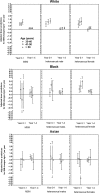Obesity Trends and Body Mass Index Changes After Starting Antiretroviral Treatment: The Swiss HIV Cohort Study
- PMID: 25734114
- PMCID: PMC4281814
- DOI: 10.1093/ofid/ofu040
Obesity Trends and Body Mass Index Changes After Starting Antiretroviral Treatment: The Swiss HIV Cohort Study
Abstract
Background: The factors that contribute to increasing obesity rates in human immunodeficiency virus (HIV)-positive persons and to body mass index (BMI) increase that typically occurs after starting antiretroviral therapy (ART) are incompletely characterized.
Methods: We describe BMI trends in the entire Swiss HIV Cohort Study (SHCS) population and investigate the effects of demographics, HIV-related factors, and ART on BMI change in participants with data available before and 4 years after first starting ART.
Results: In the SHCS, overweight/obesity prevalence increased from 13% in 1990 (n = 1641) to 38% in 2012 (n = 8150). In the participants starting ART (n = 1601), mean BMI increase was 0.92 kg/m(2) per year (95% confidence interval, .83-1.0) during year 0-1 and 0.31 kg/m(2) per year (0.29-0.34) during years 1-4. In multivariable analyses, annualized BMI change during year 0-1 was associated with older age (0.15 [0.06-0.24] kg/m(2)) and CD4 nadir <199 cells/µL compared to nadir >350 (P < .001). Annualized BMI change during years 1-4 was associated with CD4 nadir <100 cells/µL compared to nadir >350 (P = .001) and black compared to white ethnicity (0.28 [0.16-0.37] kg/m(2)). Individual ART combinations differed little in their contribution to BMI change.
Conclusions: Increasing obesity rates in the SHCS over time occurred at the same time as aging of the SHCS population, demographic changes, earlier ART start, and increasingly widespread ART coverage. Body mass index increase after ART start was typically biphasic, the BMI increase in year 0-1 being as large as the increase in years 1-4 combined. The effect of ART regimen on BMI change was limited.
Keywords: HIV infection; antiretroviral therapy; body mass index; immunosuppression; longitudinal study; obesity.
Figures


References
-
- Global Burden of Metabolic Risk Factors for Chronic Diseases Collaboration (BMI Mediated Effects) Metabolic mediators of the effects of body-mass index, overweight, and obesity on coronary heart disease and stroke: a pooled analysis of 97 prospective cohorts with 1.8 million participants. Lancet. 2014;383:970–83. - PMC - PubMed
-
- Carr A, Samaras K, Burton S, et al. A syndrome of peripheral lipodystrophy, hyperlipidaemia and insulin resistance in patients receiving HIV protease inhibitors. AIDS. 1998;12:F51–8. - PubMed
LinkOut - more resources
Full Text Sources
Other Literature Sources
Molecular Biology Databases
Research Materials

